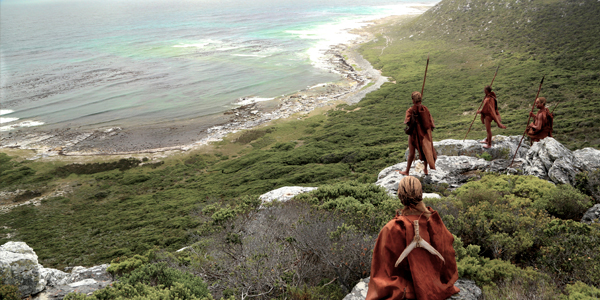Mandela and the treasure in the Blombos Cave
- Wits University
Many Norwegian researchers had a close relationship with Nelson Mandela but few as close as Christopher Henshilwood, also of Wits ESI, did.
Professor Christopher Henshilwood is SARChI Chair in The Origins of Modern Human Behaviour at the Evolutionary Studies Institute (ESI) at Wits University and the SFF Centre of Excellence, Centre for Early Sapiens Behaviour (SapienCE), University of Bergen, Norway.
The ESI and SapienCE have collaborated to present an installation of an exhibition, Origins of Early Sapiens Behaviour, on now until Friday, 31 August 2018 at the Spier Wine Farm, Stellenbosch, Western Cape, South Africa.
Nelson Mandela would have been 100 on 18 July 2018. A Norwegian journalist, Njord V. Svendsen, spoke to Henshilwood about the professor's relationship with Mandela.
The following article, translated from Norwegian, was published in På Høyden, a newspaper in Bergen, Norway, on 18 July 2018.

Mandela a patron of the pre-historic
Mandela was the first democratically elected president in South Africa. It had been 10 years since he strolled out of retirement after 27 years in jail, when he contacted the professor, who currently has offices at Sydneshaugen, Norway.
Henshilwood had just made a series of archaeological discoveries that fundamentally changed the story of the very first human being. It was a paradigm shift.
Henshilwood and research colleagues had made discoveries in the Blombos Cave in South Africa – engraved ochre, bone tools, and shell jewellery – that were up to 75,000 years old.
Mandela was very interested in history and pre-history. The current view until then was that Homo sapiens evolved in Europe after their primitive predecessors left Africa. Symbolism, it stated in the textbooks, started in Europe after 30,000 years. Artefacts thought to have been founded by the Europeans turned out not to be the case; symbolism was present 40,000 years earlier – in Africa. This interested Mandela.
“I wrote to Mandela to ask if he would accept the patronage of the Blombos Cave project”, says Henshilwood from a chair overlooking the western capital of Norway. The professor did not have high expectations; Mandela did not take many such “missions”.
“But Mandela wrote back, ‘Yes, I would gladly be the patron of the Blombos project’. I was naturally humbled,” says Henshilwood.
“Mandela was very interested in history and pre-history. He also found political implications. Initially, no one believed - from these finds - that Africans were the first to produce symbolic, cultural material 40,000 years earlier than Europeans, who saw Europe as the centre of civilization and Africa as a backwater. Our findings showed the opposite, and this was important for Mandela,” says Henshilwood.
Ancient artefacts and the African renaissance
Two years later, in 2002, Henshilwood was invited to the opening of the Houses of Parliament in Cape Town, along with the widows of famous peacekeepers, such as Moses Kotane and Steve Biko. They heard the then President Thabo Mbeki speak to the nation. Prior to that, Mbeki had inspected some of the ancient art objects Henshilwood had excavated.
By then, the discoveries that Henshilwood had told Mandela about were published in Science and other journals, and this archaeological scoop featured on the front pages of newspapers across the world. These ideas also fitted in with Mbeki's conception of the African Renaissance, which he believed would lift Africa out of colonisation.
After the session in parliament, there was a private reception and Henshilwood and Mandela had time to talk about both country and artefacts.
“Obviously it was a big occasion and he was very charismatic, but above all, it was a very down to earth man who stood before me,” said Henshilwood.
Henshilwood’s artful history
When Henshilwood began studying in Cape Town in 1970, Mandela had already been imprisoned for six years. The apartheid regime was strong and opposed dialogue.
“Nearly everyone at the university was involved in the resistance to apartheid in one way or another. Mandela represented hope, victory,” says Henshilwood, who is from a political family. His grandfather was Minister of Education in the Western Cape Province for the United Party in the 1960s. The United Party opposed the National Party, which came to power in 1948 and introduced apartheid. Henshilwood’s Great Aunt was one of the founders of the Black Sash, a women's organisation that campaigned and protested publicly against apartheid.
Henshilwood first studied commerce and then worked in business as a director. At the age of 36, he returned to the University of Cape Town to study archaeology. He had earned his bachelor’s degree by the time Mandela was released in 1990.
Today, Henshilwood alternates between a professorship in Bergen and Johannesburg, where he is a professor in the Evolutionary Studies Institute at Wits. He calls himself a “cautious optimist” with regard to South Africa's future, and he is sure that Mandela will not stop being a force in South African society.
“You can be critical about Mandela, and maybe some believe that not everything he did was right, but when South Africa was on the verge of civil war in 1994, I am completely sure that it was his personal legitimacy and values that were decisive in order for a solution to be found for our country.”
Since he received the letter from Mandela and then met him in Parliament, Henshilwood has made more 100,000-year-old findings, which again confirm that the origins of the first advanced humans lie in Africa.
“I think Mandela would have shared our excitement,” says Henshilwood.
Origins of Sapiens Behaviour exhibition is on now until 31 August 2018 in Stellenbosch, Western Cape, South Africa.
